Jesse Sharpless Cheyney, 1837-1906
by Brian Stevenson
last updated January, 2018
As an educator with experience in using lantern projectors and other technical devices as teaching tools, J.S. Cheyney joined with Samuel L. Fox and William H. Walmsley in 1870 to buy out James W. Queen’s Philadelphia scientific supply business. They named their partnership J.W. Queen & Company. Cheyney took charge of the philosophical instruments department, that is, magic lanterns, barometers, thermometers, etc. One of the new corporation’s first steps was to open a branch in New York City, which was managed by Cheyney. In early 1876, he quit the partnership, and opened his own New York shop. After that failed, in 1877, Cheyney moved back to Philadelphia and started a business that made and sold microscope slides, microscopes, photographic supplies, and other, similar goods.
As is the case with most early American slide-makers, Cheyney’s mounts are not very common these days. They are generally well made, and have held up well through the years. They were probably produced between 1878 and the time of his death, in 1906.
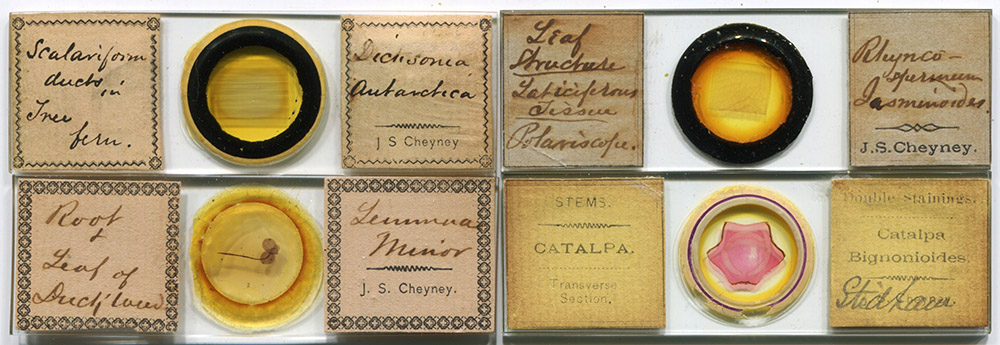
Figure 1.
Microscope slides that were produced by Jesse S. Cheyney. All were probably produced for sale at his Philadelphia business, or through retailers he supplied. The slide with typeset labels at the lower right has Cheyney’s name over-written by its probable first owner, Isaac Stidham, of Ohio.
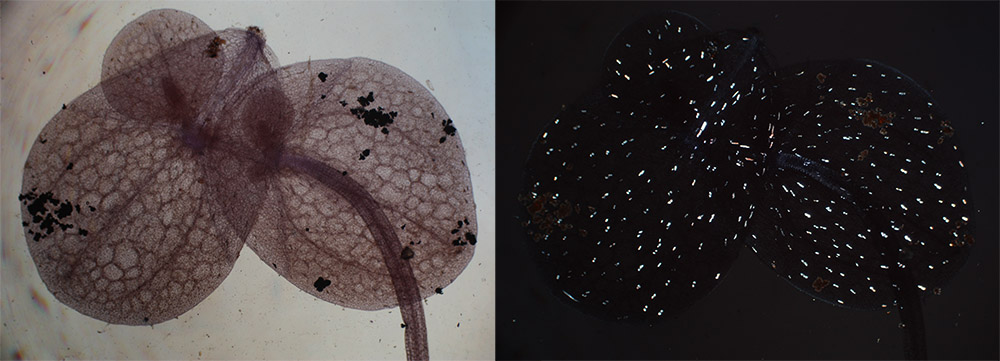
Figure 2.
Leaves of duckweed (Lemna minor), viewed under normal transmitted light or with crossed polarizing filters (polariscope). Leaves of L. minor accumulate crystals of calcium oxalate, which glow under polariscope due to their rotation of polarized light. Both photographed with a 3.5x objective lens and C-mounted digital SLR camera
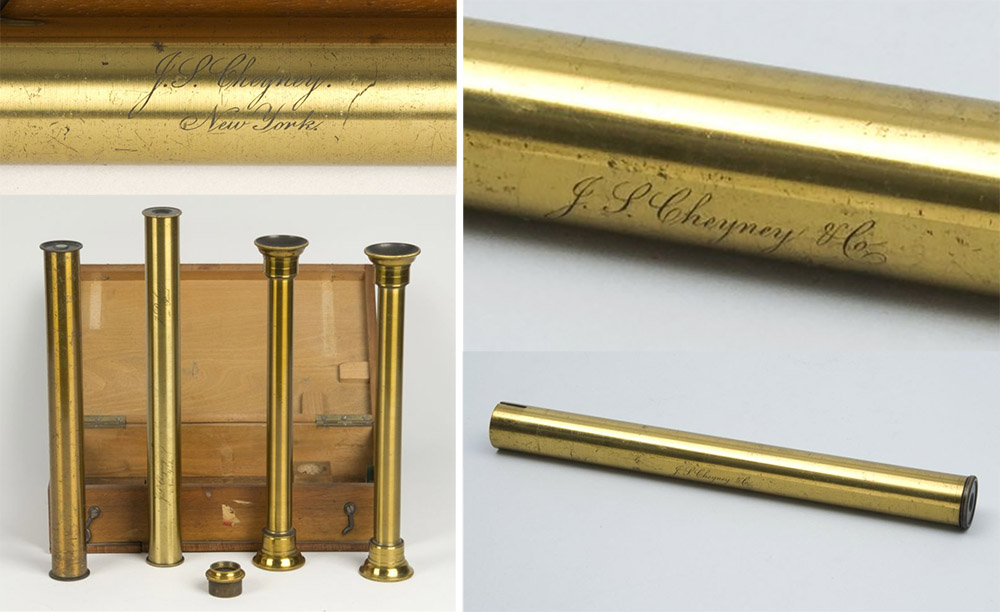
Figure 3.
Saccharometer tubes signed by Cheyney. It is probable that he imported all of these instruments, then attached his name to them. On the left, four tubes, one of which is signed “J.S. Cheyney, New York”, dating it to 1876-1877. That tube is also signed by the maker, Jules Duboscq, of Paris. On the right, a tube signed “J.S. Cheyney & Co.”, dating it to between 1880 and ca. 1900. Images adapted for nonprofit, educational purposes from the Harvard University Collection of Scientific Instruments, http://waywiser.fas.harvard.edu/people/2680 and http://waywiser.fas.harvard.edu/objects/11974.
Jesse’s parents, Joseph and Edith Sharpless Cheyney were farmers, tending 107 acres in Thornbury, Delaware that had been homesteaded by Joseph’s grandfather. Jesse Sharpless Cheyney was born there on March 4, 1837.
Cheyney worked as a teacher of classics at Westtown Boarding School, Philadelphia, between 1857 and 1866. He then became Principal of The Friends' Select School, Philadelphia, from 1866 to 1869. His familiarity with both modern instructional equipment and physical sciences is evident by his 1868 publication, “On an easy and very effective mode of showing the vibrations in Chladni plates, &c, to a large class, by the use of a calcium or electric lantern”,.
He married on October 21, 1858, to Ellen R. Moore. They had 6 children, 3 girls and 3 boys. The two elder boys, Joseph Walker Cheyney (1868-1908) and Jesse Sharpless Cheyney Junior (born 1873) were recorded in issues of The Naturalists’ Directory as having interests similar to their father’s, and might have helped him with making slides.
James W. Queen, a noted Philadelphia manufacturer and supplier of scientific goods, announced his retirement in 1870. He also proclaimed that his business would be continued by his former partner, Samuel L. Fox, the noted microscopist William H. Walmsley, and Jesse S. Cheyney. The business was divided into three sections, with Cheyney taking “the Department of Philosophy, which will comprise Magic Lanterns, Oxy-Calcium and Dry-Hydrogen Stereoscopticons, with Pictures and Illustrations from all countries and upon all scientific subjects; Thermometers, Barometers, Globes, Air Pumps, Electric Machines, Magnetic Apparatus, &c., &c.”.
The new business promptly opened a second location, in New York. Directories and other records indicate that Cheyney served as manager, although he lived a distance away in the more affordable town of Rahway, New Jersey. The initial site was at 5 Dey Street. During May-June, 1871, the shop was moved to 535 Broadway. A third move occurred during mid-February, 1873, to 601 Broadway.
The original partnership of James W. Queen & Co. was dissolved in early 1876, with Cheyney going his own way. Walmsley and Fox formed a new James W. Queen & Co., which lasted until 1877. A February, 1876 announcement read, “James W. Queen & Co. - This well-known firm has been once more dissolved, Mr. Cheyney carrying the department of philosophical apparatus with him to Bond Street, New York City. The remaining partners, S.L. Fox and W.H. Walmsley, retain the microscopical branch of the business at the old stand and under the old name. Microscopists will find G.S. Woolman in charge of their department at the New York store”.
It appears that Cheyney was working independently from Queen prior to the business breakup. In November, 1875, the New York City Board of Education authorized payments to both James W. Queen & Co. and Jesse S. Cheyney.
Cheyney set up at 1 and 3 Bond Street, New York. Business was evidently not as good as Cheyney had anticipated. By the end of 1876, he was over $5000 in debt. To save himself, Cheyney took on a silent partner, Howard L. Underhill, in January, 1877. The agreement was that Underhill contributed cash to the partnership, Cheyney contributed the goods, and the pair split profits and losses. The Bond Street building suffered from a fire on March 6, 1877, necessitating a move to 27 Great Jones Street. Although Underhill was supposed to handle all of the bookkeeping, Cheyney deposited some of the proceeds into his personal bank account. In addition, he made withdrawals from another bank, adding to his personal debt. The Cheyney-Underhill partnership ended on November 1, 1877. These details came to light in published court documents, where the bank to whom Cheyney was indebted attempted to collect those debts from Underhill (he had money of his own, whereas Cheyney was broke). The case was resolved by a ruling that a person is not responsible for the personal debts of a business partner.
Cheyney moved back to Philadelphia in late 1877, and formed a new business. A catalogue was issued in 1878, “of mounting apparatus and material and of microscopic objects. Made for sale, wholesale and retail”. Slides such as those shown in Figure 1 probably date from this time, at the earliest.
His slides were well received. For example, a report on the Soiree of the Microscopical Society of Camden, New Jersey stated, “Mr. J.S. Cheyney, of Philadelphia, not being able to attend, had sent a donation of three dozen slides to the cabinet of the Society, which are also very perfect, and at the next regular meeting will be formally presented”.
It appears that financial troubles arose again. By 1880, the business was named “J.S. Cheyney Optical Co., Limited”, with Cheyney as Secretary and General Manager. I have not located information on the other officers or who supplied the money.
The company continued to sell Cheyney’s microscope slides and material, and added equipment such as microscopes and other instruments (see Figure 3). Most, if not all, of those instruments were probably brought in from outside manufacturers.
Cheyney and Co. displayed 11 microscopes at the April 5, 1883 Annual Exhibition of the Biological and Microscopical Section of the Academy of Natural Sciences of Philadelphia. Published comments included:
“The microscopes shown by J.S. Cheyney had no pretension to fine finish, and could doubtfully be classed among instruments of precision”.
“Beck and J.S. Cheyney each exhibited cameras adapted to microscopes for micro-photography by lamp-light. It is claimed that good results, with amateurs, can be secured in that way. The apparatus, however, contained nothing new, and the results gained (if a judgment may be based upon a number of pictures shown) indicate no recent advance in this kind of amateur photography. We accept it as better than nothing, but the eye instructed in detail is always disappointed”.
“J.S. Cheyney also exhibited a projection microscope, carrying a quadruple nose-piece, for photographic transparencies, polariscope, microscope and spectroscope, for projection. It is claimed that all these parts will swing into accurate centre, and can be instantly changed during a lecture. Your committee did not see the apparatus in action and therefore cannot more fully report”.
A distant relative, Joseph P. Cheyney, owned a series of photography businesses in Philadelphia, which should not be confused with our microscopist’s businesses. There were some connections, however, such as this announcement from 1881, “Dry plate amateur outfits are made a specialty by Wolf & Cheyney, 821 Filbert Street, Philadelphia, who also keep a full supply of all kinds of photographic requisites. Those who are interested in the microscope and its accessories will be pleased to learn that Messrs. Wolf & Cheyney have been made the Philadelphia agents for the various optical goods manufactured by the J.S. Cheyney Optical Co., Limited, and which includes microscopes, microscopic preparations and supplies”.
Slide-making appears to have been Cheyney’s personal forte. He was consistently listed in the Naturalists’ Directory as having particular interest in microscopy, general histology, and botany. The 1885 and 1886 editions included a note that he “desires diatomaceous earth and diamond beetles from all countries”, both of which would be desirable for making slides. He was still commercially producing slides in 1900 (Figure 13). Cheyney presumably continued to do so until his death, which occurred on January 29, 1906.
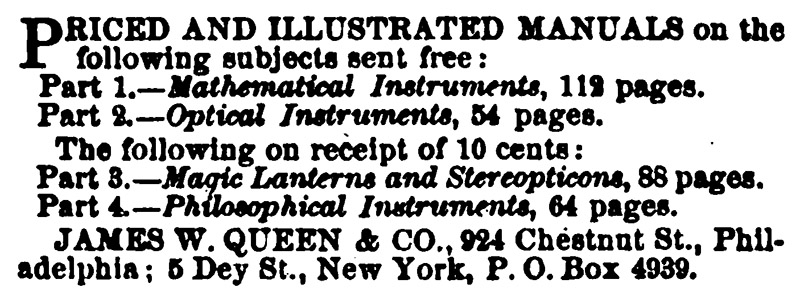
Figure 4.
One of the first advertisements by James W. Queen & Co., from the September 10, 1870 issue of “Harper’s Weekly”’. It announced their two shops: the site previously occupied by James Queen in Philadelphia, 924 Chestnut Street, and the new shop in New York City, 5 Dey Street. Jesse Cheyney was manager of the New York site.
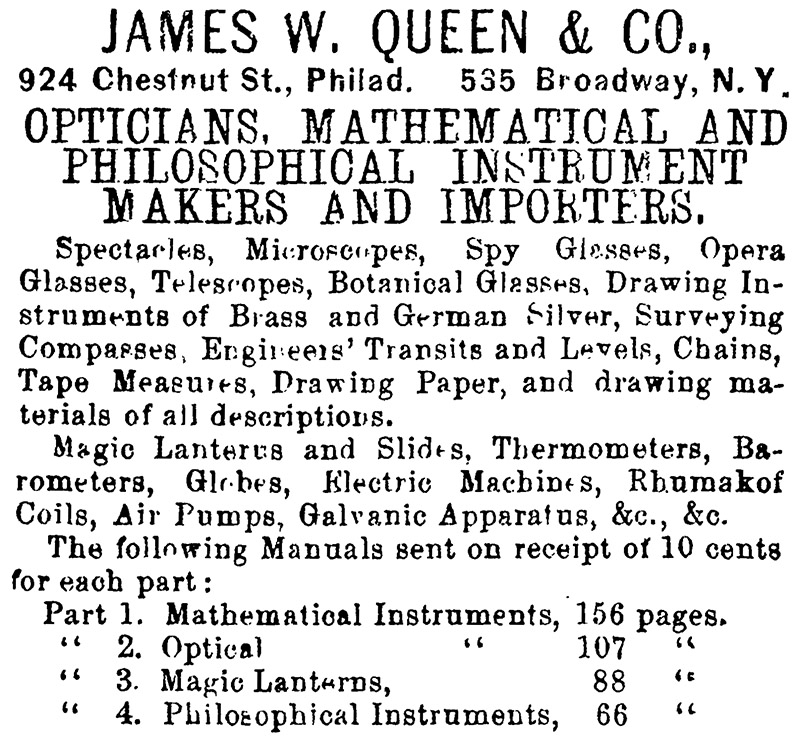
Figure 5.
J.W. Queen & Co. moved to 535 Broadway, New York, during May or June, 1871. Advertisement from the August 12 issue of “The Friends’ Intelligencer”.
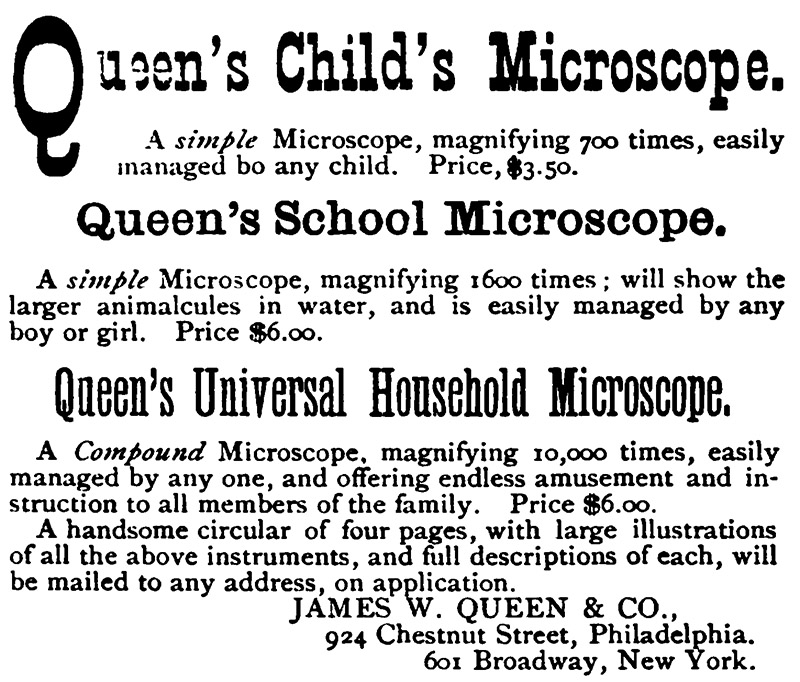
Figure 6.
Another move occurred, during February, 1873, to 601 Broadway, New York. Advertisement from the November, 1874 issue of “Schooldays Magazine”.
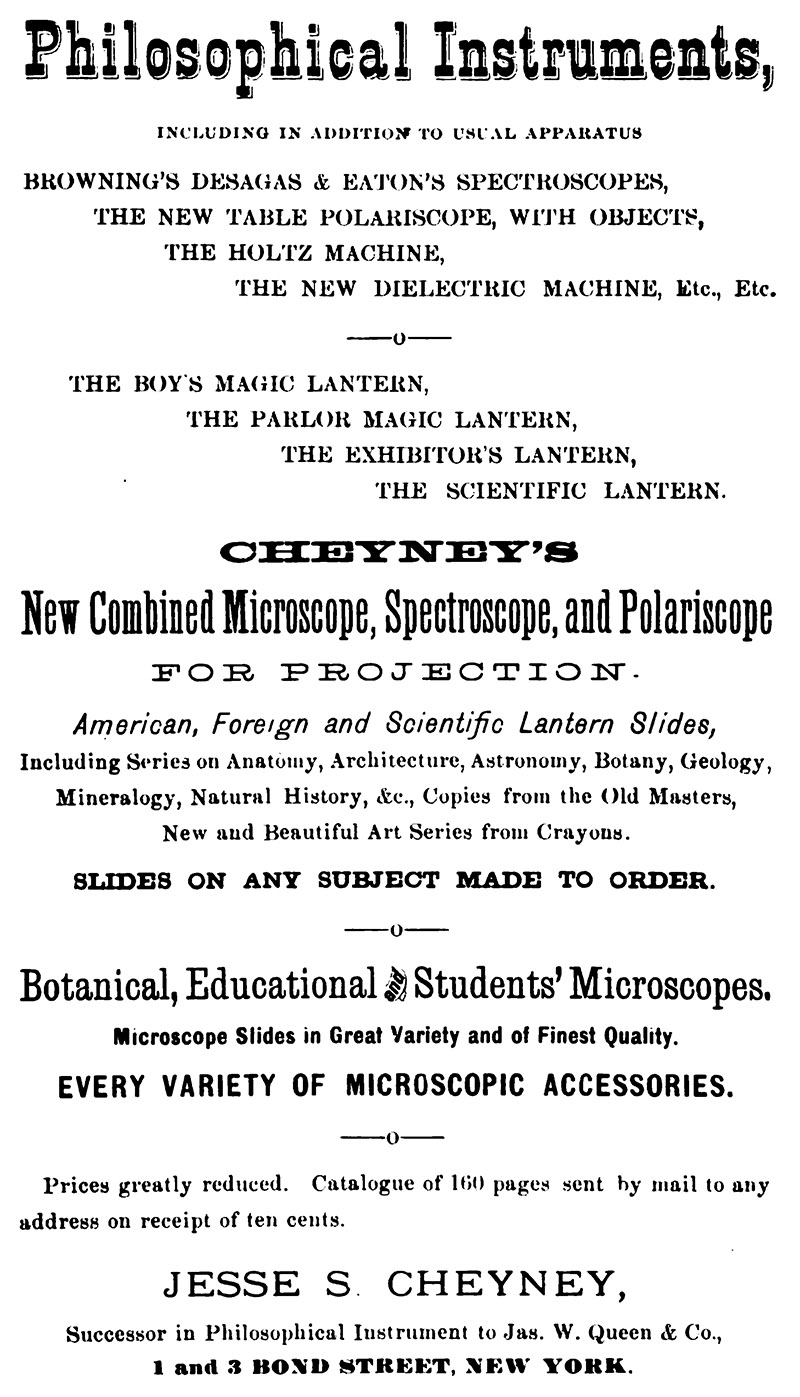
Figure 7.
Cheyney left James W. Queen & Co. in February, 1876. He moved the philosophical instruments to his new shop, at 1 & 2 Bond Street, New York. Advertisement from the 1876-77 Catalogue of Cornell College, Mount Vernon, Iowa.
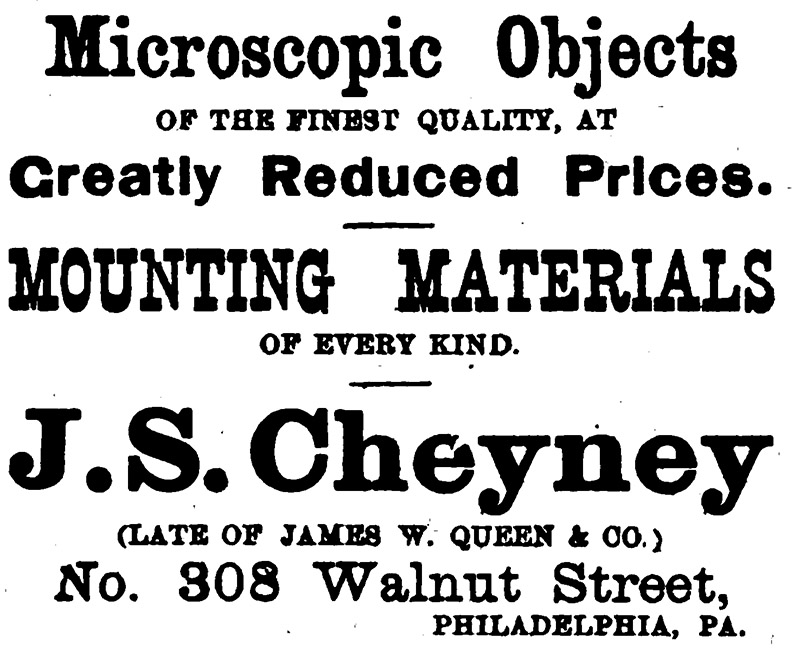
Figure 8.
Cheyney was back in Philadelphia before the end of 1878. Microscope slides, such as those shown in Figure 1, were a significant component of his business. Cheyney’s shop was located at 308 Walnut Street. By this time, his former partner, William Walmsley, had also departed Queen, and was manager for the U.S. outlet of R. & J. Beck, located a short distance away at 1016 Chestnut Street. The third partner, Samuel L. Fox, now had sole ownership of James W. Queen & Co., located at 924 Chestnut Street.
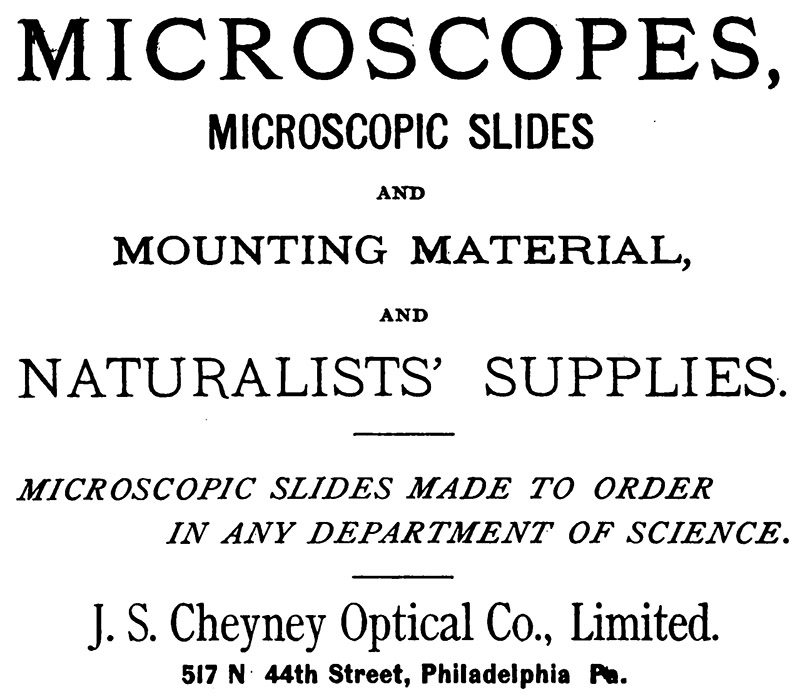
Figure 9.
�A move and a re-organization, circa 1880. Cheyney’s business became a limited corporation, in which he was listed as Secretary and General Manager. The business address, 517 North 44th Street, was also the family home. The official report of the 1883 Exhibition of the Biological and Microscopical Section of the Academy of Natural Sciences of Philadelphia stated, “The microscopes shown by J. S. Cheyney had no pretension to fine finish, and could doubtfully be classed among instruments of precision”. Advertisement from the 1880 “Naturalists’ Directory”.
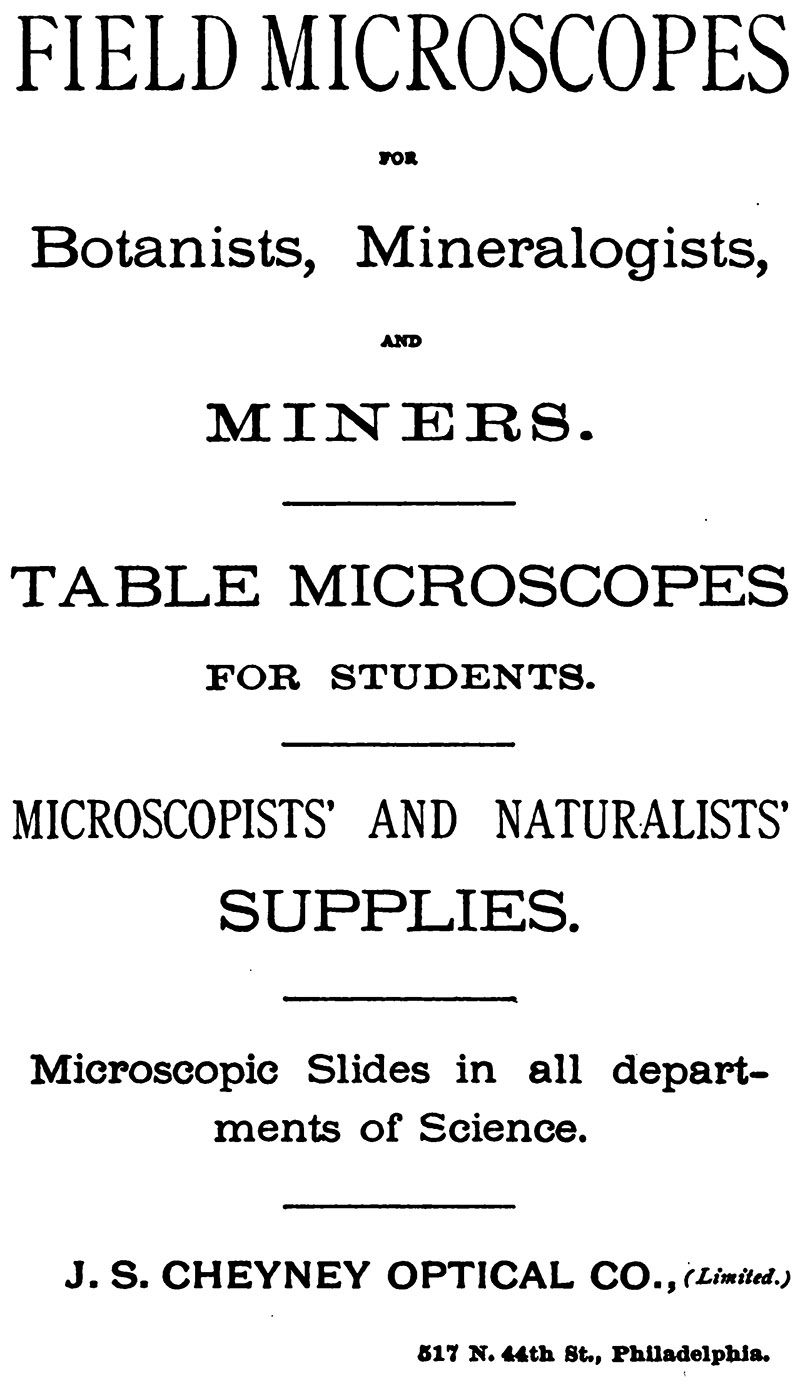
Figure 10.
Advertisement from the 1882. Regarding Cheyney’s microscopes, the official report of the 1883 Exhibition of the Biological and Microscopical Section of the Academy of Natural Sciences of Philadelphia stated, “The microscopes shown by J.S. Cheyney had no pretension to fine finish, and could doubtfully be classed among instruments of precision”.
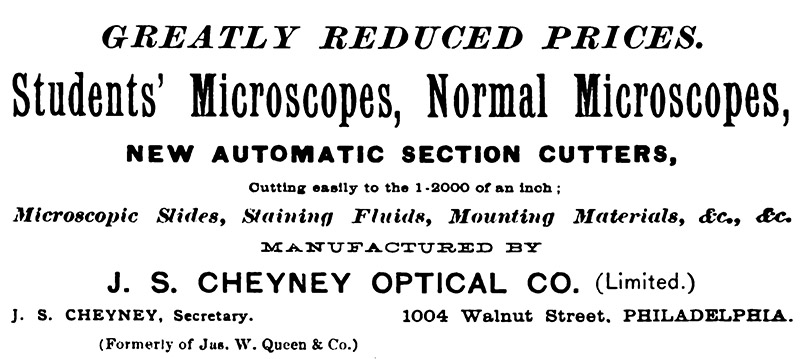
Figure 11.
Another move in Philadelphia, to 1004 Walnut Street. Advertisement from an 1883 issue of “The American Monthly Microscopical Journal”.
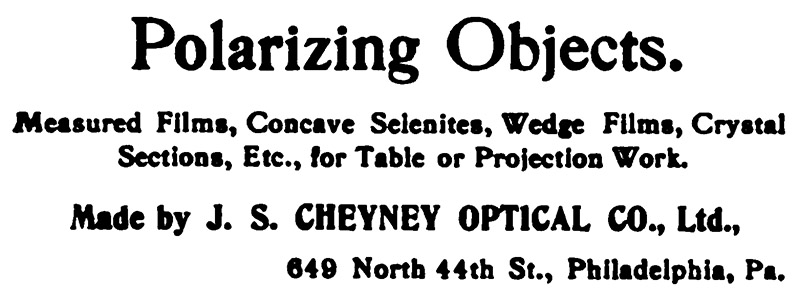
Figure 12.
An advertisement from an 1899 issue of “The Journal of Applied Microscopy”, indicating another move, to 649 North 44th Street.
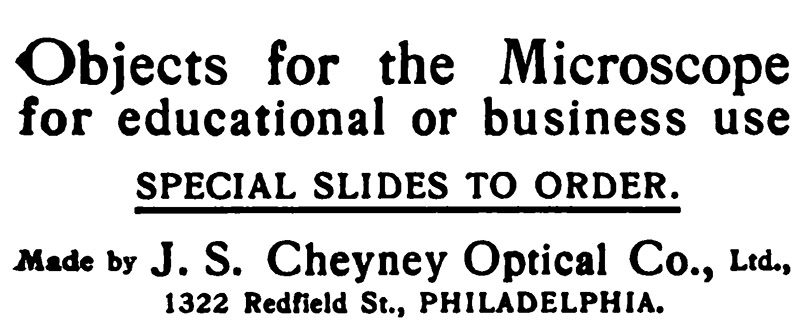
Figure 13.
From a 1900 issue of “The Journal of Applied Microscopy”. Cheyney was still producing microscope slides in commercial quantities.
Resources
The American Journal of Microscopy and Popular Science (1879) Advertisement from J.S. Cheyney, Vol. 4, September issue, front cover
The American Journal of Microscopy and Popular Science (1880) Report on the Soiree of the Microscopical Society of Camden, N.J., Vol. 5, pages 121-122
The American Naturalist (1876) Vol. 10, February issue, page 123
Annual Report of the American Institute of the City of New York (1871) “Premiums awarded at the thirty-ninth annual Exhibition”
Catalogue of Cornell College, Mount Vernon, Iowa (1876) Advertisement from J.S. Cheyney
Cheyney, Jesse S. (1868) On an easy and very effective mode of showing vibrations in Chladni plates, &c., to a large class, by the use of a calcium or electric lantern, American Journal of Science, Vol. 46, pages 243-244
Cheyney, J.S. (1878) Catalogue of Mounting Apparatus and Material and of Microscopic Objects, Philadelphia
Cheyney, J.S. (1900) On the gradual deterioration of balsam mounts, Microscopical Bulletin and Science News, Vol. 17, page 3
Cheyney, J.S. (1900) Hints on collecting material for class work, Microscopical Bulletin and Science News, Vol. 17, pages 34-35
Cheyney, J.S. (1900) Fresh water sponges, Microscopical Bulletin and Science News, Vol. 17, page 36
Cope, Gilbert (1882) “Cheyney, Jesse S., b Thornbury, Del. Co., 3, 4, 1837; m. Haverford College Mtg., 10, 21, 1858, Ellen R. Moore, b. Haverford twp., 11, 27, 1835; dau. of Walker Moore and Mary Ann Roberts, of Haverford. He was a classical teacher at Westtown Boarding School, 1857 to 1866; principal of Friends' Select School, Phila., 1866 to 1869; of the firm of James W. Queen & Co., opticians, 1870 to 1875, and secretary and general manager of the J. S. Cheyney Optical Co., 1878 to the present. Res., 649, N. 44th St., Phila. Children, Joseph W., b. Westtown, 9, 13, 1866; Marianna, b. Phila., 11, 5, 1868; Edith S., b. same, 2, 3, 1871; Jesse S., b. Rahway, N. J., 3, 3, 1873; Algernon R., b. same, 12, 28, 1874; Phebe, b. same, 3, 3, 1877; Ellen M., b. Phila., 8, 28, 1878; d. aged three weeks”, Genealogy of the Sharpless Family, page 855
Court of Appeals (1886) The Union National Bank of Rahway, New Jersey against Howard L. Underhill
Dental Practitioner (1883) Annual Exhibition of the Biological and Microscopical Section of the Academy of Natural Sciences of Philadelphia, Vol. 1, pages 72-74
Friends Intelligencer (1871) Advertisement from J.W. Queen & Co., Vol. 28, August 12 issue
Harper’s Weekly (1870) Advertisement from J.W. Queen & Co., Vol. 14, September 10 issue, page 592
Harper’s Weekly (1873) Advertisements from J.W. Queen & Co. Address 535 Broadway in February 15 issue, Address 601 Broadway in February 22 issue, Vol. 17
Journal of Applied Microscopy (1900) Advertisements from J.S. Cheyney Optical Co. Ltd., Vol. 3
Journal of the Board of Education of the City of New York (1875) “Nov. 3, 1875, Commissioner Wood presented a report from the Committee on Normal Schools, approving for payment sundry bills for apparatus, &c., supplied the Normal College, and accompanied with the following resolution: Resolved, That the following named bills be, and they hereby are approved for payment: James W. Queen & Co., Department of Natural Science $151.85, Jesse S. Cheyney, Department of Physics $26.50”, page 703
The Lens (1872) Reprint of letter from James W. Queen of April 11, 1870, Vol. 1
The Naturalists’ Directory (1880) “Cheyney, J.S., 517 N 44th St, Philadelphia. Mic Slide Mounts, Crypt. Bot. C. Ex. mounted slides for diatomaceous earth”, page 94
The Naturalists’ Directory (1880) Advertisement from J.S. Cheyney & Co., Limited, at the back of the book
The Naturalists’ Directory (1882) Advertisement from J.S. Cheyney & Co., Limited, at the back of the book
The Naturalists’ Directory (1885) “Cheyney, J.S., 1004 Walnut St., Phila., Pa. Mic. Gen. Histol., Bot. Desires diatomaceous earth and diamond beetles from all countries”, page 94
The Naturalists’ Directory (1886) “Cheyney, J.S., 1004 Walnut St., Phila., Pa. Mic. Gen. Histol., Bot. Desires diatomaceous earth and diamond beetles from all countries”, page 94
The Naturalists’ Directory (1895) “Cheyney, J.S., 649 N. 44th St., Phila., Pa. Physical Optics, Elect., Mic. Gen. Histol., Bot.”, page 36
The Photographic Times and American Photographer (1881) Vol. 11, pages 461-462
The Queen Catalogues (1887) Vol. 1, Norman Publishing, Philadelphia
Schoolday Magazine (1873) Advertisements from James W. Queen & Co.
Scientific American (1870) “James W. Queen & Co., the well-known mathematical and optical instrument makers, of Philadelphia, have opened a branch of their establishment in this city, at No. 5 Dey St. Their advertisement appears in our advertising columns. We can recommend this firm to such of our readers as desire to purchase articles in their line or trade”, September issue, page 149
The Technologist (1871) “There are some half-dozen dealers in New York who keep really first-class drawing materials; and among these we can name with confidence the firm of James W. Queen & Co., who have lately removed from No. 5 Dey Street to No. 535 Broadway, New York”, Vol. 2, June issue, page 167
U.S. census and other records, accessed through ancestry.com
Wilson, Wendell E. (accessed 2018) Jesse S. Cheyney, Mineralogical Record, http://www.minrec.org/labels.asp?colid=1073












